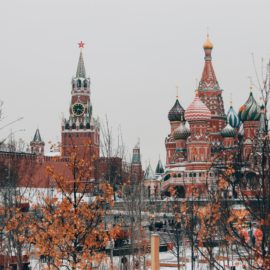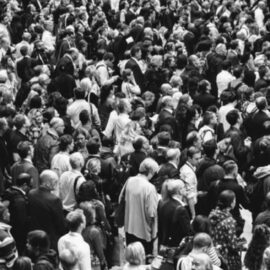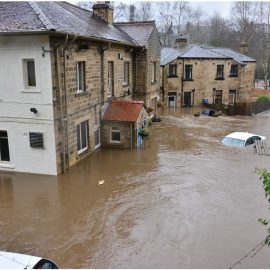
This is a free excerpt from one of Shortform’s Articles. We give you all the important information you need to know about current events and more.
Don't miss out on the whole story. Sign up for a free trial here .
Looking for examples of government surveillance? How do governments legislate and use mass surveillance?
Nowadays, governments and corporations around the world openly collect data on who we are and how we live our lives. To better understand mass surveillance, it’s best to explore some examples of how government agencies across the world practice it.
Read on for a selection of historical and modern examples of government surveillance.
Examples of Government Surveillance
In addition to domestic mass surveillance, the prominence of the internet allows private companies and governments to conduct global mass surveillance efforts—indiscriminately collecting data on people all over the world. This article will detail global examples of government surveillance via intelligence agencies, policies, and legislation.
This global surveillance often occurs through collaborations between governments and corporations—for example, the Chinese company Bytedance (creator of the popular app TikTok) collects data on its users and allegedly collaborates with the Chinese government, while the United States government allegedly buys consumer data from private companies. While some countries (particularly those in the European Union) have passed privacy laws limiting the collection of information, these laws often require the consent of users rather than banning information collection outright—meaning under these laws people can either consent to be surveilled or choose not to use the vast majority of the internet. This also means that no matter what country you live in, if you use the internet, you’re almost certainly being watched.
Surveillance and Law
As Cold War tensions lessened, some governments began to establish their intelligence agencies more concretely through law instead of keeping them entirely secret. Sometimes this was due to popular backlash against these agencies, while other times it was just done to firmly establish the role of intelligence agencies in government. Efforts to legislate mass surveillance (and intelligence activity in general) had two main consequences:
1) Oversight: Intelligence agencies began operating under increased government oversight. In practice, this didn’t stop or strongly limit mass surveillance. Instead, it made these operations more integrated with civilian governments as opposed to the mostly-independent agencies of the ’50s and ’60s.
2) Legality: In addition to increased government oversight, many countries legally acknowledged their intelligence agencies and explicitly gave them legal authority to use different forms of surveillance. These laws limited the more egregious abuses of intelligence agencies (like Project MKULTRA, a CIA operation that secretly gave Americans LSD in an attempt to develop mind control) but also established them (and mass surveillance) as permanent government fixtures.
Examples
Israel: In 1987 the Israeli government created The Landau Commission to investigate Shin Bet’s (Israel’s internal intelligence agency) use of physical force in interrogations. The commission discovered that Shin Bet commonly used torture in attempts to gain information from Palestinian prisoners. Furthermore, it also established a legal precedent for this torture by supporting the use of a “moderate measure of physical pressure” and establishing guidelines for what that meant. However, reports since the commission show that Shin Bet continued (and continues) to use torture methods much harsher than those guidelines.
The United Kingdom: Throughout the 1980s, British Prime Minister Margaret Thatcher began to create a legal framework for her intelligence agencies to use mass surveillance—for example, section 94 of the Telecommunications Act 1984 ensured that the government had the power to monitor and control all telecommunications with little oversight (as long as it was an issue of “national security”), while the Security Service Act 1989 formally recognized the existence and legality of MI5 (the United Kingdom’s internal intelligence agency) for the first time, despite the agency having operated for many decades prior.
The United States: In 1975, several government committees revealed the illegal activities of the CIA, FBI, NSA, and IRS during the previous two decades. This led to a partial increase in oversight and rules against some of the agencies’ worst abuses (including a ban on the assassination of foreign leaders).
Despite significant public backlash, however, the U.S. government began granting intelligence agencies legal permission to conduct mass surveillance—for example, President Jimmy Carter signed the Federal Intelligence Surveillance Act (or FISA) in 1978, granting intelligence agencies the authority to electronically surveil whomever they believe is a threat so long as they have either approval from the president or a warrant issued by a secret court (known as a FISA court). How much these requirements limited intelligence agencies is up for debate—between 1976 and 2006, FISA courts received 22,987 requests for surveillance, approved (or modified and approved) 22,982 of them, and rejected five.
In addition, in 1981, U.S. President Ronald Reagan signed Executive Order 12333 which further established the legality of electronic surveillance by intelligence agencies.
Post-Colonial Turmoil
Meanwhile, during the late Cold War, many post-colonial nations across Africa and Asia struggled with political turmoil resulting from internal instability and interference from foreign intelligence agencies (mainly the CIA). This turmoil led many governments (new and old) to create police states and use mass surveillance in an attempt to maintain their hold on power. Often, a regime would fall and its replacement would continue using many of the same intelligence methods and institutions.
Examples
Argentina: Following a coup, a military junta (supported by the CIA’s Operation Condor) took over Argentina from 1976 until 1983. The junta (along with Operation Condor’s right-wing death squads) monitored, interrogated, tortured, and killed anyone they suspected of harboring leftist views—including journalists, union leaders, and members of student groups.
Iran: During the 1970s, the CIA-backed Shah’s intelligence agency SAVAK grew increasingly violent, imprisoning and torturing suspected dissidents with impunity. In 1979, however, the Iranian Revolution deposed the Shah and installed a new Islamist republic. Though the information is contested, some sources suggest that Ayatollah Ruhollah Khomeini (the new republic’s first supreme leader) kept many former SAVAK staff and structures for Iran’s successor intelligence agency, the Ministry of Intelligence (initially known as SAVAMA).
Iraq: After several attempted coups and assassinations against Iraqi dictator Saddam Hussein in the 1970s and 1980s, the Iraqi Intelligence Agency grew extensively as part of Hussein’s attempt to tighten his grip on power. The IIS (also sometimes known as the Mukharabat) often used brutal and violent tactics to monitor and repress dissent.
Surveillance in Modern Times
With the collapse of the Soviet Union and the end of the Cold War, many intelligence agencies lost their original justifications for the use of mass surveillance. However, they soon found new justifications for its expanded use—and new technologies to conduct surveillance on a larger scale than ever before.
Below, we’ll briefly describe some examples of modern government surveillance methods.
Methods
Video surveillance: Modern security cameras create a higher-quality image and can store far more footage. Governments often use traffic cameras and can take footage from security cameras of private businesses.
GPS Tracking: Improvements in satellite technology and the prevalence of smartphones allow governments to track people’s locations and movements.
Internet activity: Governments can survey people’s internet activity—the messages they send, the websites they visit, and the applications or programs they use.
Algorithms and artificial intelligence: Governments can use computer algorithms and artificial intelligence to detect patterns of behavior, learn about people, and even predict what they’ll do next. These programs can analyze things like biometric data (faces, voices, gait, fingerprints, DNA) and online posts and pictures.
Removing Limitations
In the past several decades, many governments have written legislation to enable mass surveillance and remove any limitations on it. This is a significant shift from earlier policies: While previously governments might have had secretive or ambiguous policies regarding mass surveillance, more countries today are willing to simply acknowledge that they use mass surveillance with little to no oversight or limitations—meaning that for billions of people across the world, unrestricted mass government surveillance has become a well-known fact of life.
Examples
China: The Chinese Communist Party began rapidly expanding mass surveillance in the past two decades using internet tracking software, millions of video cameras, and AI analyzing movements and biometric data. They’ve also passed a number of laws and measures supporting these efforts, like a 2016 law requiring internet companies to store six months’ worth of data in mainland China or a 2019 law that controls and monitors the internet use of teenagers.
Russia: Initially passed in 1995, Russia’s SORM (and SORM 2) law has expanded over time, allowing the government to monitor all forms of communication without a warrant. In addition, Russia has expanded its video surveillance network under the guise of COVID-19 regulations, using millions of video cameras and facial recognition software to track people and their movements.
The United States: Under President George W. Bush, the United States passed the Patriot Act in 2001 following the 9/11 terrorist attacks. The Patriot Act allows the U.S. government to monitor communications and collect data on American citizens without a warrant. In 2013, former NSA (National Security Agency) contractor Edward Snowden revealed that the agency was indiscriminately monitoring telephone and internet communication—provoking no significant government response. Further documents show that the NSA regularly uses facial recognition technology, and U.S. law regarding biometric privacy is ambiguous.

Want to fast-track your learning? With Shortform, you’ll gain insights you won't find anywhere else .
Here's what you’ll get when you sign up for Shortform :
- Complicated ideas explained in simple and concise ways
- Smart analysis that connects what you’re reading to other key concepts
- Writing with zero fluff because we know how important your time is






